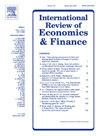从“人口红利”到“数字红利”:老龄化背景下产业结构升级路径探索
IF 5.6
2区 经济学
Q1 BUSINESS, FINANCE
引用次数: 0
摘要
本研究探讨了人口老龄化背景下产业结构升级的驱动机制从“人口红利”向“数字红利”的转变。基于中国30个省份(2012-2022年)的均衡面板数据,双向固定效应模型揭示了人口老龄化如何通过服务型结构调整重塑产业动态,而数字化转型成为维持产业升级势头的关键途径。基于数字发展水平的分组回归分析表明,老龄化驱动的产业升级效应在不同数字成熟阶段存在显著的区间差异。空间德宾模型进一步揭示了双路径溢出效应:人口老龄化促进了相邻区域的积极示范效应,而数字进步在经济联系区域表现出“虹吸效应”,将资源从周边地区转移。实证结果表明:在控制区域异质性后,老年人口比例的上升对服务业结构调整具有统计学显著的正向影响;数字转型与人口老龄化的交互系数呈现非线性特征,只有当数字指数超过临界阈值时,二者的协同效应才显著;空间效应分解表明,人口老龄化对周边地区的产业转型具有正向示范效应,而数字发展将在经济关联度高的地区产生“虹吸效应”,从而抑制周边地区的升级进程。本文章由计算机程序翻译,如有差异,请以英文原文为准。
From "demographic dividend" to "digital Dividend": An exploration of the path of industrial structure upgrading in the context of aging
This study investigates the transition from "demographic dividend" to "digital dividend" in driving industrial structural upgrading under population aging. Based on balanced panel data from 30 Chinese provinces (2012–2022), a two-way fixed effects model reveals how population aging reshapes industrial dynamics through service-oriented restructuring, while digital transformation emerges as a critical pathway to sustain upgrading momentum. Grouped regression analysis based on digital development levels demonstrates significant interval variations in the effect of aging-driven industrial upgrading across different digital maturity stages. Spatial Durbin model further uncovers dual-path spillovers: aging facilitates positive demonstration effects across neighboring regions, yet digital advancement exhibits a "siphon effect" in economically linked areas, diverting resources from peripheral zones. The empirical results show that: After controlling for regional heterogeneity, the increase in the proportion of the elderly population has a statistically significant positive impact on the restructuring of service-oriented industries; The interaction coefficient between digital transformation and population aging presents nonlinear characteristics, and their synergistic effect is only significant when the digital index exceeds a critical threshold; The spatial effect decomposition indicates that population aging has a positive demonstration effect on the industrial transformation of neighboring regions, while digital development will produce a "siphon effect" in areas with high economic connections, thereby inhibiting the upgrading process of surrounding regions.
求助全文
通过发布文献求助,成功后即可免费获取论文全文。
去求助
来源期刊
CiteScore
7.30
自引率
2.20%
发文量
253
期刊介绍:
The International Review of Economics & Finance (IREF) is a scholarly journal devoted to the publication of high quality theoretical and empirical articles in all areas of international economics, macroeconomics and financial economics. Contributions that facilitate the communications between the real and the financial sectors of the economy are of particular interest.

 求助内容:
求助内容: 应助结果提醒方式:
应助结果提醒方式:


